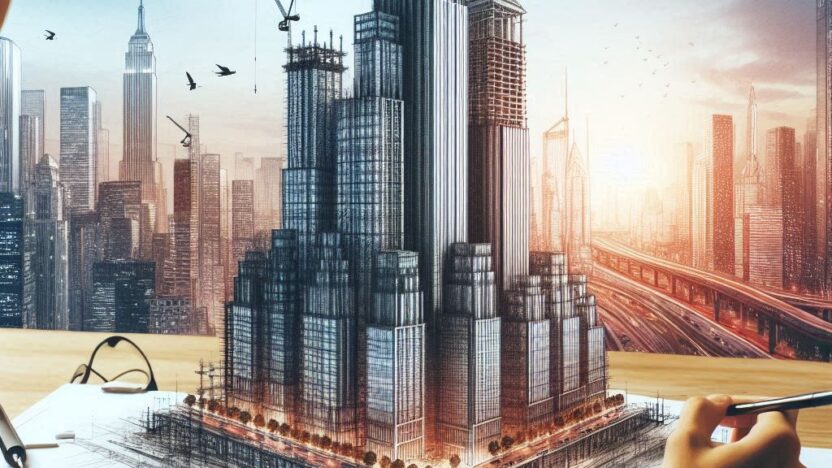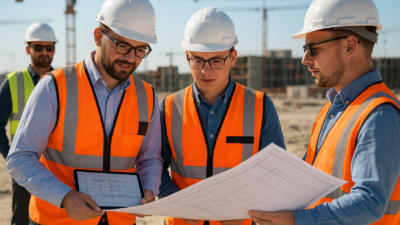Steel detailing is a meticulous process that involves creating shop drawings, erection drawings, and comprehensive documentation to guide steel fabricators, steel erectors, engineers, and other stakeholders in constructing safe, efficient, and resilient structures. From structural steel detailing to ensuring the seamless installation of miscellaneous steel, this essential process bridges the gap between design intent and practical application.
The unsung heroes of urban skylines, steel detailers, work tirelessly to translate architectural visions detailed shop drawings, and structural drawings into actionable plans and drawings. They ensure that each steel member, from beams to braces, fits perfectly within the larger structure, embodying both form and function.
Importance of Steel Detailing
The significance of steel detailing in the construction industry cannot be overstated. It is the backbone structure of projects ranging from skyscrapers to bridges.
Take the iconic Empire State Building, for instance: its enduring stability is a testament to the precision and expertise of structural and miscellaneous steel detailing.
Steel detailing bridges the gap between architectural, translate design intent, and on-site construction, offering:
- Enhanced Structural Integrity: By ensuring that every steel structure aligns with the design phase, detailing guarantees structures withstand heavy loads and environmental stressors.
- Efficient Resource Allocation: Accurate construction documents minimize material waste, optimizing costs and timelines.
- Improved Safety: Well-detailed plans reduce risks during the construction process, ensuring safer assembly and long-term durability of installed components.
Key Components of Steel Detailing
Shop Drawings
Shop drawings form the cornerstone of the detailing process. These shop drawings will provide detailed plans special instructions for fabricating each steel component, specifying dimensions, materials, welding symbols, and specific requirements for surface treatments. They act as the guiding light for fabrication shops, ensuring precision and quality.
Erection Drawings
Erection drawings are equally critical, offering on-site guidance detailed information for contractors and steel erectors during assembly. These drawings include erection information dimensions, bolting connection details, welding instructions, and detailed schematics to ensure components are installed accurately.
Key Differences Between Shop Drawings and Erection Drawings:
| Aspect | Shop Drawings | Erection Drawings |
| Purpose | Fabrication and assembly details | Site placement and installation guidance |
| Information Included | Materials, dimensions, welding instructions | Positioning, bolting, on-site assembly steps |
| Intended Audience | Fabricators | Construction team |
Bill of Materials (BOM)
The bill of materials (BOM) is a vital document for construction drawings that lists all materials required for the project. This aids project managers in cost estimation, inventory management, and ensuring the availability of every component needed for the construction project.
The Detailing Process in Steel Construction
Detailing begins with the design phase, where detailers collaborate with engineers to draft initial designs. This evolves into detailed drawings, 3D models and drawings, culminating in a set of final documents that guide the fabrication and construction of several phases thereafter. It follows a series of steps, ensuring that every component aligns with design intent and regulatory standards.
- Initial Design Phase: The journey begins with the structural engineer’s preliminary designs, which outline the layout, dimensions, and specific details of the structure. Detailers collaborate closely with engineers to interpret the design drawings, ensuring that each element aligns with the design intent.
- Drafting and Modeling: Using advanced tools like Tekla Structures, detailers create 2D and 3D models that include every detail needed, such as connections, welding instructions, and materials. These models provide a comprehensive view of the structure, helping teams detect and resolve clashes during the construction process.
- Review and Revision: Every drawing undergoes rigorous reviews to ensure adherence to standards like AISC and local compliance codes. This phase involves multiple iterations, refining the working drawings to meet both project-specific and regulatory demands.
- Final Documentation: The process concludes with the generation of shop drawings, erection drawings, and a detailed BOM. These documents serve as the foundation for fabricators, contractors, and sub-contractors, enabling precise execution of the project.
Challenges in Steel Detailing
Detailers face numerous challenges, from interpreting complex architectural designs to coordinating with the architect and multiple engineering teams. Balancing intricate design aesthetics with structural safety demands high precision and extensive expertise.
Complexity of Modern Designs
Contemporary architectural styles often feature intricate designs and non-standard components, demanding advanced expertise and software. Detailers must account for all the components’ unique shapes and specific requirements, ensuring that even the most complex steel structures are accurately detailed.
Coordination Across Disciplines
Steel detailing requires seamless collaboration with multiple teams, including architects, structural engineers, and contractors. Effective communication is essential to ensure all teams are on the same page, avoiding conflicts and delays.
Cost Optimization
Efficient use of materials is paramount. Detailers play a critical role in optimizing layouts and selecting suitable components, reducing waste without compromising quality.
Key Standards and Compliance in Steel Detailing
Compliance with standards like AISC, ACI, and Eurocodes ensures that all structural steel and components meet safety, durability, and regulatory requirements. For instance, in seismic zones, adherence to these standards guarantees that the structural steel framework can withstand potential earthquakes, protecting lives and property. Major standards include:
| Standard | Region | Purpose |
| AISC (American Institute of Steel Construction) | United States | Structural design and fabrication guidelines |
| AWS (American Welding Society) | United States | Welding specifications and safety guidelines |
| Eurocodes | Europe | Structural integrity and safety regulations |
| BS (British Standards) | United Kingdom | Detailed building and structural codes |
| IS 800 (Indian Standards) | India | Local steel detailing and construction standards |
Ensure compliance and precision in your projects with BuildTwin. Get Started here
The Role of Technology in Modern Steel Detailing
Technology is revolutionizing the detailing process, making it faster and more accurate. Tools like CAD and BIM are essential in creating detailed drawings and detecting potential clashes during the building’s design phase and fabrication process.
- CAD Software: CAD software enables precise 2D and 3D detailing, facilitating early issue detection and resolution.
- BIM (Building Information Modeling): BIM provides a holistic view of the building lifecycle, including detailed 3D models and lifecycle data, aiding in clash detection and coordination.
- Additional Technologies: 3D scanning, augmented reality, and AI are becoming more common, providing enhanced visualization and conflict resolution.
List of steel detailing software:
| Title and developer | 2D/3D | Supports BIM? | Supports IFC? |
| StruCAD by AceCad | 2D/3D | Yes | Yes |
| Bocad by AVEVA | 2D/3D | Yes | Yes |
| Advance Steel by Autodesk | 2D/3D | Yes | Yes |
| AutoSD, Inc. | 2D | No | No |
| Parabuild | 2D/3D | Yes | Yes |
| ProSteel by Bentley Systems | 2D/3D | Yes | Yes |
| Tekla Structures by Trimble Navigation | 2D/3D | Yes | Yes |
| TecnoMETAL by Steel&Graphics | 2D/3D | Yes | Yes |
| SDS2 by Nemetscheck | 2D/3D | Yes | Yes |
| Soft Steel | 2D/3D | Unknown | Unknown |
| SSDCP | 2D | Unknown | Unknown |
| SOLIDWORKS | 3D | Unknown | Unknown |
| TSD (The Steel Detailer) | 3D | Unknown | Unknown |
| TSteel 3D by Techsteel | 2D/3D | Yes | Yes |
Choosing the Right Steel Detailing Partner: Key Considerations
Selecting the right steel detailing partner is crucial for the success of your projects. The right partner brings expertise, reliability, and a thorough understanding of standards and compliance, ensuring that each steel component fits perfectly and performs as expected. Here are essential factors to consider when choosing a steel detailing partner:
1. Project Complexity Assessment
Identify the complexity of your project to match it with a detailing partner possessing the appropriate technical expertise.
2. Reputable Providers
Choose partners with a strong industry reputation, proven track record, positive client reviews, and necessary certifications.
3. Software Legitimacy
Ensure your partner uses licensed and updated software like Tekla or AutoCAD to avoid errors and delays.
4. Review Past Projects
Examine the partner’s previous work and seek client references to gauge reliability and quality.
5. Standards Knowledge
Verify that your partner is knowledgeable about relevant local and international standards to ensure compliance.
6. Communication Skills
Opt. for partners with strong communication and a dedicated project manager to maintain clear and effective collaboration.
7. Transparent Workflow
Understand their workflow, timeline, and flexibility to adapt to changes, ensuring alignment with your project schedule.
8. Compare Pricing and Value
Evaluate cost against the overall value offered, balancing price with expertise, capabilities, and resource availability.
9. Trial Project Option
Consider requesting a trial or a sample to assess the partner’s skills and suitability for your own set of needs.
10. Direct Engagement
Interview potential partners to evaluate their expertise, professionalism, and ability to meet project requirements.
Choosing the right partner for steel detailing can make or break a project’s success. With accurate construction drawings, compliance with international standards, and seamless collaboration, a trusted partner ensures your project stays on track and achieves excellence. To connect with top-tier structural steel detailing experts, explore BuildTwin’s Steel Detailing Services here.
Future Trends in Structural Steel Detailing
As sustainability and building technology evolve, steel detailing continues to adapt, incorporating:
- AI and Machine Learning: Automating repetitive detailing tasks and analyzing data to optimize structural design.
- Sustainability Considerations: Detailing with eco-friendly materials and waste-reduction strategies to support sustainable construction practices.
- Cloud-Based Collaboration: Enabling real-time collaboration among globally distributed teams, cloud platforms enhance detailing efficiency and consistency.
- Digital Twins: Digital twins create a virtual representation of physical assets, allowing real-time monitoring and optimization throughout the construction and operational phases.
Comparison of Traditional vs. Modern Steel Detailing Techniques
| Feature | Traditional Techniques | Modern Techniques |
| Software Usage | Basic CAD | Advanced BIM, AI, AR |
| Environmental Impact | Higher material wastage | Optimized, sustainable materials |
| Team Collaboration | Localized, delayed communication | Cloud-based, real-time collaboration |
Conclusion
Steel detailing is more than just the information required when creating construction documents; it’s about ensuring that every steel element fits perfectly into the larger design vision. As technology and standards evolve, the role of the detailer will continue to grow in importance, ensuring that structures not only rise but endure
Ready to elevate your projects with expert detailing? Partner with BuildTwin to connect with a wide array of pre-qualified, skilled vendors and designers who prioritize accuracy, compliance, and efficiency in steel detailing. Explore BuildTwin’s Steel Detailing Services here.



